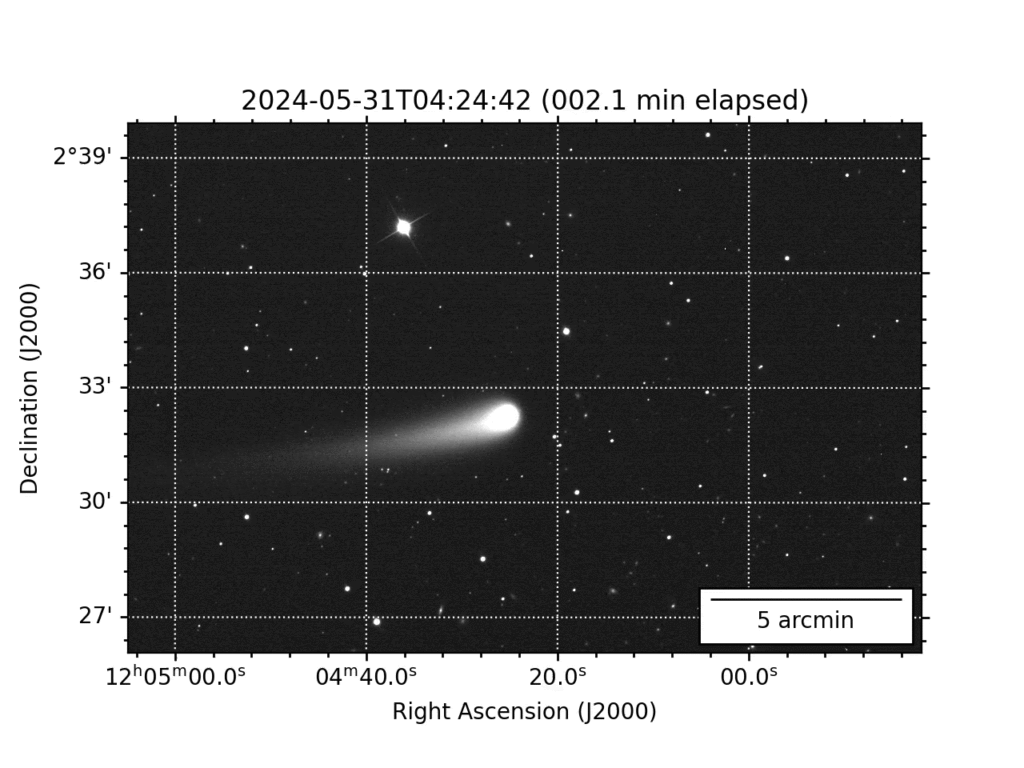
An image from a series of frames charting Tsuchinshan-ATLAS's course, captured by astronomer Ryan Hamilton using the new Peggy and Eric Johnson 1m Telescope at Lowell's Anderson Mesa Station. Credit: Ryan Hamilton
Excitement is building among astronomers and skywatchers for Comet Tsuchinshan-ATLAS (C/2023 A3), which is steadily brightening and developing a visible tail. As of early May 2024, the comet’s magnitude reached around 10, making it a captivating target for those with telescopes. Observers have reported a condensed coma and a curving tail, contributing to its growing allure.
However, it’s crucial to manage expectations regarding its visibility. While the comet is anticipated to brighten further, especially as it approaches the Sun, it might not reach the spectacular levels of brightness that some might hope for. Current projections suggest it could reach magnitude 8.5 by early July and potentially 6.5 by mid-August for equatorial and Southern Hemisphere observers. If it releases enough dust, it might even become visible with binoculars or small telescopes later in the year.
What to Expect
Observing Challenges and Tips:
- Brightness Variability: Comets are unpredictable, and while Tsuchinshan-ATLAS might brighten, it could also dim unexpectedly. Be prepared for variability.
- Viewing Times: The best times to view the comet will be during early morning hours or late evening, depending on your location.
- Light Pollution: For optimal viewing, seek out dark skies away from urban lights.
- Weather: Clear skies are essential. Cloud cover or haze can obscure the view, so check local weather forecasts.
Position and Viewing Conditions:
- Viewing Geometry: Lowell postdoctoral fellow Qicheng Zhang noted that in mid- to late April, the comet’s tail was behind the coma, boosting its apparent brightness. This spike wasn’t due to intrinsic activity, but to the viewing angle.
- Tracking: Throughout June, observers with access to dark skies can track C/2023 A3 in a 6-inch telescope as it moves northwest across Virgo.
Future Prospects:
- October Highlights: The comet will be favorably positioned for viewing just after sunset in mid-October, potentially showcasing a dust tail and anti-tail formation.
- Potential Outbursts: Barring any outbursts (always a possibility with comets), Tsuchinshan-ATLAS should gradually brighten.
Embracing the Experience
Even if Comet Tsuchinshan-ATLAS doesn’t deliver a dazzling display, the journey of tracking and observing it is rewarding. Stargazing allows us to connect with the cosmos and appreciate its wonders. Remember, the joy of astronomy lies not just in the final observation but in the anticipation and exploration.
So, grab your binoculars, find a dark spot, and look up. Whether you glimpse the comet or simply enjoy a night under the stars, you’ll be part of a timeless tradition of celestial exploration!
For more detailed information and updates, visit Sky & Telescope.
Happy stargazing!